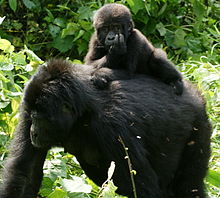Eastern gorilla
| Eastern gorilla | |
|---|---|
 |
|
| Male | |
 |
|
| Female with infant | |
| Scientific classification | |
| Kingdom: | Animalia |
| Phylum: | Chordata |
| Class: | Mammalia |
| Order: | Primates |
| Suborder: | Haplorhini |
| Family: | Hominidae |
| Genus: | Gorilla |
| Species: | G. beringei |
| Binomial name | |
|
Gorilla beringei Matschie, 1903 |
|
| Subspecies | |
 |
|
| Eastern gorilla range | |
The eastern gorilla (Gorilla beringei) is a critically endangered species of the genus Gorilla and the largest living primate. At present, the species is subdivided into two subspecies. Grauer's gorilla, formerly known as the eastern lowland gorilla (G. b. graueri) is more populous, at about 3,800 individuals. The mountain gorilla (G. b. beringei) has only about 880 individuals. The International Union for the Conservation of Nature mentioned illegal hunting in its assessment of threats to the species.
There are two recognised subspecies of eastern gorilla: the mountain gorilla (Gorilla beringei beringei) of the volcanic slopes of Rwanda, Uganda and eastern Democratic Republic of Congo; and Grauer's gorilla or eastern lowland gorilla (Gorilla beringei graueri) in eastern Democratic Republic of Congo.
Grauer's gorillas and mountain gorillas were previously thought to be two of the three subspecies of one single species, the gorilla (Gorilla gorilla). However, genetic research has shown that the two eastern subspecies are far more closely related than the western subspecies: the western lowland gorilla (G. gorilla gorilla), which justified the separate classification. The two eastern subspecies are now classified as G. beringei.
The eastern gorilla is a large hominid with a large head, broad chest, and long arms. It has a flat nose with large nostrils. The face, hands, feet and breast are bald. The fur is mainly black, but adult males have a silvery "saddle" on their back. When the gorilla gets older, the hair on the saddle of the back becomes white, much like the gray hair of elderly people. This is why the older males are called silverbacks. Grauer's gorilla has a shorter, thicker, deep black fur, while the mountain gorilla has a more bluish color. The mountain gorilla is slightly smaller and lighter than Grauer's gorilla, but still larger and heavier than the western lowland gorilla and the Cross River gorilla. Males are much larger than females. A full-grown adult male Eastern gorilla typically weighs 140–205.5 kg (309–453 lb) and stands 1.7 m (5.6 ft) upright and a female typically weighs 90–100 kg (200–220 lb) and stands 1.5 m (4.9 ft) tall. The tallest silverback recorded was a 1.94-metre (6.4 ft) individual shot in Alimbongo, northern Kivu in May 1938. The heaviest gorilla recorded was a 1.83-metre (6.0 ft) silverback shot in Ambam, Cameroon which weighed about 266 kilograms (586 lb), although the latter area is within the range of the western gorilla, far outside that of the eastern gorilla.
...
Wikipedia

